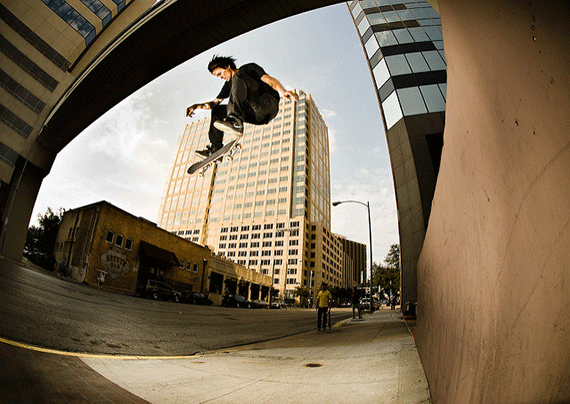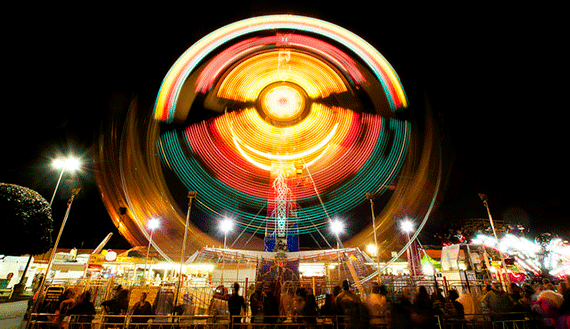Getting great photographs of the world in motion is a difficult task. More than any other kind of photography, action photography demands lightning-quick reflexes, a solid foundation in composition and other photo elements, and a little bit of luck. That being said, anyone can learn to take great action shots if they’re willing to commit a little time to understanding the methods to the madness. Here are some techniques to get you started taking action photos:

Photo by Perry Hall; ISO 100, f/5.6, 1/320-second exposure.
Know Your Subject Matter
Due to the short amount of time you have to shoot, it’s important that you understand the subject you’re photographing. For example, with basketball, if you’re not near the basket, you won’t get a good picture of the next dunk. Before you start shooting a particular subject in action, take time to understand your subject so you can anticipate the action before it happens.
Get the Subject in Action
You want to always try to get the subject at the time when the action is at its maximum impact. For example if you’re photographing snowboarders jumping off a ramp, know what type of shot you want. Do you want the launch, the landing, or the highest part in the jump? Action photography can be captivating if you compose the picture to include the most interesting part of the action. So, always be thinking of the best way to compose your picture.
Focus in Advance
Many professional photographers focus their cameras on an empty space where they expect something to happen. This is an easy thing to do if you know the activity you’re shooting, and it will save you valuable time when someone is flying through the air in your frame and you have milliseconds to react.
Pan with the Subject
It is important in action photography that you convey motion in the final print. While some subjects will have obvious motion, such as a basketball player frozen mid-dunk, others may require a bit of work on your part. Panning is when you move your camera to keep up with the subject as they pass in front of you. This will give you the end result of the subject being clearly in focus but the background being blurred by the motion of the camera.

Photo by Chris Sawtelle; ISO 100, f/11.0, 2-second exposure.
Using the Right ISO and Using a Flash
High ISO is usually best for action photography. The high light sensitivity will let you use faster shutter speeds in more varied light situations and help you to freeze actions perfectly. For ultra fast movements, a flash can also be helpful; however, most built-in camera flashes won’t work well beyond 10 feet.
Frame the Image for Action
Try not to simply stop the action of a subject in your photograph. While freezing an action in progress is a good goal for an action shot, allow the viewer room to follow the action to a possible conclusion. For example if you have someone jumping down some stairs, position the subject near the top of the picture and have some stairs below so it’s easier to understand the outcome of the action.
Digital Makes it Easier
Action photography takes an enormous amount of patience and practice. Thanks to digital cameras and their near-endless supply of photographs, you can practice your action shots without taking a huge hit on your wallet. And even better, many modern cameras have continuous shooting modes that allow you to shoot 10-50 images in rapid succession, so you can have more opportunities for the perfect shot.

Photo by Bubba’s Bag of Photos; f/2.8, 0.5-second exposure.
Anytime your shooting action photography, safety needs to come first so you can avoid injuring yourself or the subject in motion. Never position yourself where you run the risk of getting hit by vehicles or athletes, and make sure that the people you are shooting are aware of where you’ll be during the activity. Beyond that, the more you shoot, the better you’ll get!
About the Author:
Autumn Lockwood is a writer for Your Picture Frames and loves taking pictures. Your Picture Frames makes it easy for you to find just the perfect frame for your photo or artwork.
Like This Article?
Don't Miss The Next One!
Join over 100,000 photographers of all experience levels who receive our free photography tips and articles to stay current:




Amazing
Anticipation!
Incredible photography! You are an obviously experienced shutterbug. Give us more.
The ability to pre-focus is critical, and it is a skill that takes a lot of practice.
On the surface, the average photographer would think it would be a boring photo to take. “Into the Station” uses strong diagonals and the feeling of motion through using a slow shutter speed to get a very interesting photo. The lighting works very well too.
I wonder if you had to “clean up” the flooring very much?
Thanks,
Bruce